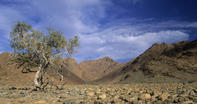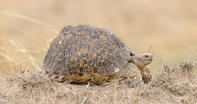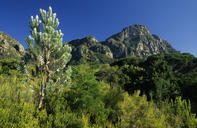Change in Celsius
The South African National Biodiversity Institute reported in 2001 that a general rise in temperature in South Africa would be experienced across the country, but with greater increases in the interior.

The Northern Cape may see a 2.5°C to 4.5°C increase in January temperatures while the coast, which is moderated by the influence of the ocean, will see about 0.5°C to 1°C increase. More recent and refined modelling has downscaled the results to be more region-specific.
These results suggest that summertime changes will see temperature increases 'in excess of 1°C with the highest temperature changes in excess of 4°C', anticipated during late spring and early summer. Heat stress and changed rainfall will probably result in greater runoff, evaporation and drying out of soils.
South Africa 'will experience increased summer rainfall over the convective region of the central and eastern plateau and the Drakensberg while the Western Cape will see slight drying in summer and a slight decrease in wintertime frontal rainfall'.
Science Says it All

Given that so much of the country varies from 'semi-arid to hyper-arid with only a few relatively humid parts where rainfall greatly exceeds 500 mm annually’, these changes could have a profound impact on the way the country looks in the future. When scientists wanted to understand how the country's animals would respond to this change, they decided to try a theoretical simulation.
They took the bioclimatic data for 179 birds, mammals, tortoises, lizards, snakes, beetles, butterflies, antlions and termites - all, to some degree, representative of animals across different family groups and different ecological regions in the country - and punched it into a computer climate model.
Then they cranked up the heat by a theoretical 2°C and left the machine to crunch the numbers. What it spat out at the end looked something like this: all but three per cent of the species shifted their range in some way - 17 percent of species expanded their range; 78 per cent contracted their range; two per cent became locally extinct.
Most telling is that the bulk of the range shifts were in an easterly direction, which reflects the 'east-west aridity gradient' across the country.
Troubled Times Ahead
Troubled times are coming to the continent, both in South Africa and further north. The World Resources Institute's 2003 Millennium Ecosystem Assessment said that the collective problems of AIDS, population growth, urbanisation, disease, low literacy, poverty and political instability in regions of Africa would profoundly impact upon the cumulative effects and related pressures on biodiversity.
Changes in land cover, spreading deserts and soil erosion, continued invasion by alien species, pollution and unsustainable use of resources will continue to grind biodiversity into the ground.
Table Mountain was Ablaze

In January 2000 nearly 8 500 hectares of fynbos and 17 homes were reduced to cinders by wildfires across the length of the Table Mountain range: in Deer Park above the City Bowl, Silvermine, Scarborough, and in and around the Cape Peninsula National Park (CPNP).
Malherbe and a group of fellow volunteer South African National Parks honorary rangers offered their services to the section ranger for the Silvermine reserve and worked the fire non-stop for 32 hours. Out of the ashes of this catastrophe, the Volunteer Wildfire Services grew. People from every level of Cape Town's social strata came forward in an extraordinary show of philanthropy - doctors, council workers, lawyers, secretaries, women and men - Christian, Muslim and atheists.
They offered their time and, possibly even their lives, to save the Cape's precious fynbos and many of the houses which dot the perimeter of the park from the devastation of these fires.
By Leonie Joubert